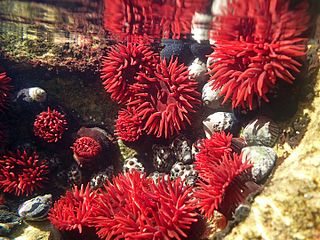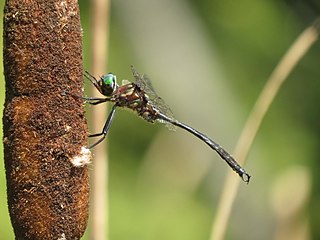| Epiplema tenebrosa | |
|---|---|
| Scientific classification | |
| Domain: | Eukaryota |
| Kingdom: | Animalia |
| Phylum: | Arthropoda |
| Class: | Insecta |
| Order: | Lepidoptera |
| Family: | Uraniidae |
| Genus: | Epiplema |
| Species: | E. tenebrosa |
| Binomial name | |
| Epiplema tenebrosa Hampson | |
| Epiplema tenebrosa | |
|---|---|
| Scientific classification | |
| Domain: | Eukaryota |
| Kingdom: | Animalia |
| Phylum: | Arthropoda |
| Class: | Insecta |
| Order: | Lepidoptera |
| Family: | Uraniidae |
| Genus: | Epiplema |
| Species: | E. tenebrosa |
| Binomial name | |
| Epiplema tenebrosa Hampson | |

The dusky moorhen is a bird species in the rail family and is one of the eight extant species in the moorhen genus. It occurs in India, Australia, New Guinea, Borneo and Indonesia. It is often confused with the purple swamphen and the Eurasian coot due to similar appearance and overlapping distributions. They often live alongside birds in the same genus, such as the Tasmanian nativehen and the common moorhen.

The Epipleminae or epiplemiine moths are a subfamily of the lepidopteran family Uraniidae. The subfamily was first described by George Hampson in 1892. They are the most diverse and widespread uraniid group, occurring mainly throughout the Pantropics but barely reaching into the temperate regions. The Epipleminae are notable for the sexually dimorphic tympanal organ which is unlike any other lepidopteran's in details of its morphology. Some species are also peculiar in being able to roll their wings into a stick-like shape, possibly as a form of crypsis. Such behavior has hitherto only been found in this subfamily and the quite unrelated Ennominae.
The gloomy tube-nosed bat is a species of vesper bat in the family Vespertilionidae. It is only known by the holotype, an old female, collected on Tsushima Island in 1962. It might be possibly extinct as Tsushima is badly deforested and surveys to rediscover this species failed. Due to its imperiled status, it is identified by the Alliance for Zero Extinction as a species in danger of imminent extinction.

The brown trembler is a species of bird in the family Mimidae, the mockingbirds and thrashers. It is found on the islands of Saba, St. Kitts, Nevis, Montserrat, Guadeloupe, Dominica and St. Vincent in the Lesser Antilles of the Caribbean Sea.

The morningbird is a songbird species in the family Pachycephalidae.
The sooty shrikethrush is a species of bird in the family Pachycephalidae. It is found in the New Guinea Highlands. Its natural habitat is subtropical or tropical moist montane forests.

The dusky gerygone is a species of bird in the family Acanthizidae. It is endemic to coastal central and northern areas of Western Australia.
The Makira fantail or dusky fantail is a species of bird in the family Rhipiduridae. It is endemic to the Solomon Islands.
The dusky babbler is a species of bird in the family Leiothrichidae. It is found in Democratic Republic of the Congo, Ethiopia, Sudan, and Uganda. Its natural habitat is subtropical or tropical moist shrubland.
Carelia tenebrosa was a species of small, air-breathing, land snail, terrestrial pulmonate gastropod mollusc in the family Amastridae.

Littorina saxatilis, common name the rough periwinkle, is a species of small sea snail, a marine gastropod mollusc in the family Littorinidae, the winkles or periwinkles. First identified in the 1700s, it has been misidentified as a new species 112 times.

Sasunaga tenebrosa is a moth of the family Noctuidae first described by Frederic Moore in 1867. It is found from the Indian subregion, Sri Lanka to Sundaland, the Philippines and Sulawesi.
Tonna tenebrosa is a species of large sea snail, a marine gastropod mollusk in the family Tonnidae, the tun shells.

Actinia tenebrosa, commonly known as the waratah anemone, is the most common species of sea anemone found in the waters of eastern Australia and New Zealand. It is found relatively high on the seashore, in rock pools, and various cracks and shaded surfaces such as under rock overhangs in the intertidal zone.

Epiplema is a genus of moths in the family Uraniidae described by Gottlieb August Wilhelm Herrich-Schäffer in 1855. A number of species have been reassigned to Europlema.

Epiplema himala is a species of moth of the family Uraniidae. It is found in Asia, including India and China.
Dysaethria conflictaria, or Epiplema conflictaria, is a moth of the family Uraniidae first described by Francis Walker in 1861. It is found in Indo-Australian tropics of India, Sri Lanka, Thailand, Papua New Guinea, the Solomon Islands and Australia.
Epiplema quadristrigata is a moth of the family Uraniidae first described by Francis Walker in 1866. It is found in Australia and Sri Lanka.

Somatochlora tenebrosa, the clamp-tipped emerald, is a species of emerald dragonfly in the family Corduliidae. It is found in North America.

Epiplema anomala is a species from the genus Epiplema. The species was originally described by Anthonie Johannes Theodorus Janse in 1932.